Indiana’s terrain is full of extraordinary vegetation from the Great Lakes Plains region down through the Till Plains and beyond. And some of its amazing plants are highly poisonous. Learn more by reviewing our list of 11 poisonous plants found in Indiana that are very dangerous. You may recognize some of them, but can you identify them all? Discover where these plants thrive and why they are so toxic if touched or ingested. In addition, you’ll learn about some of the troubling symptoms that US poisonous plants could cause humans or animals.

1. Autumn Crocus (Colchicum autumnale)

The poisonous autumn crocus is a popular garden plant and grows wild in wooded areas with moist soil.
©Greens and Blues/Shutterstock.com
The autumn crocus, a.k.a. meadow saffron, is a popular garden perennial that blooms in the fall. It produces large lavender-pink or white flowers with long petals and narrow basal leaves. Many other crocus varieties bloom in the spring. So this plant is a favorite for its spring-like pastel flowers that appear in early fall. However, be aware that the autumn crocus is poisonous.
Though popular as garden flowers, autumn crocus plants also grow in the wild in wooded areas and meadows with moist soil. The autumn crocus is also easy to naturalize over time in non-native areas. However, it’s the wildly-growing plants that present the most danger to foragers and grazing livestock.
Plant Toxicity: Autumn Crocus
Unfortunately, one of the disadvantages of autumn crocus plants blooming in the fall is that their spring growth looks similar to that of wild garlic (Allium ursinum). So accidental poisonings can happen when people forage for wild garlic but pick young and poisonous autumn crocus plants instead.
The autumn crocus contains a toxic alkaloid called colchicine, which blocks normal DNA synthesis and other body functions. Ingesting any part of the autumn crocus plant could lead to nausea, diarrhea, vomiting, and stomach pain. Additional and life-threatening symptoms that may take days to develop include organ failure and cardiac collapse, leading to death.
2. Belladonna (Atropa belladonna)
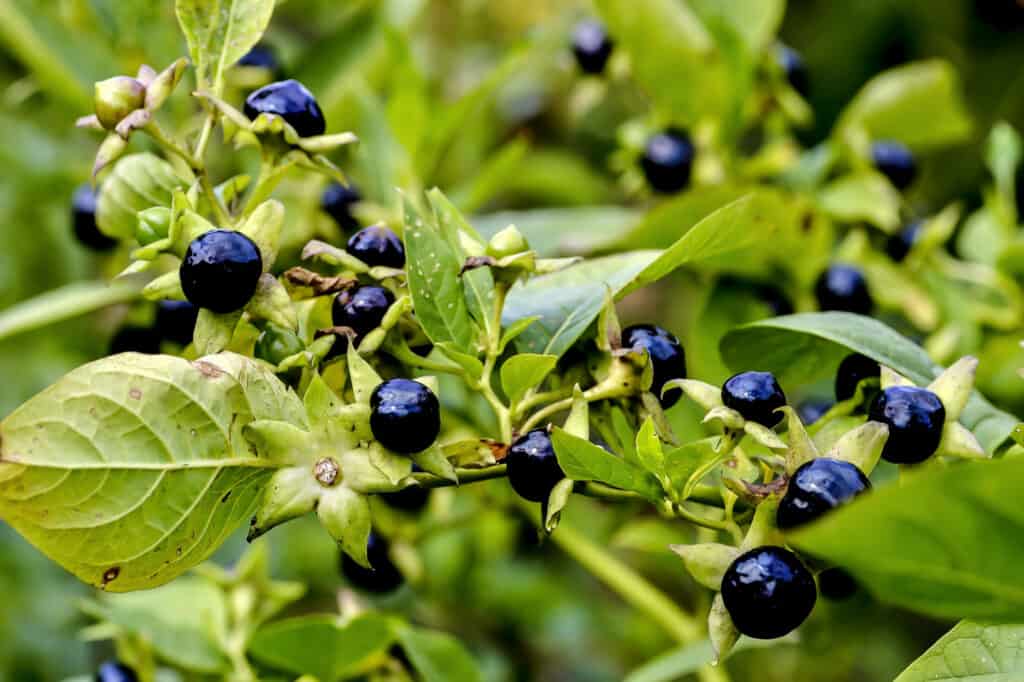
Belladonna, or deadly nightshade plants, are highly poisonous perennial shrubs with dark, shiny berries.
©Simon Groewe/Shutterstock.com
The dangerous belladonna plant, also known as the deadly nightshade, is a perennial shrub that is extremely dangerous if ingested. And belladonna’s high toxicity has been well-known since at least the 1700s.
This poisonous plant found in Indiana features purple or greenish bell-shaped flowers and shiny black berries. Belladonna tends to grow in woodlands, along fences and walls, and in other partly-shady marginal areas.
Plant Toxicity: Belladonna
The toxic tropane alkaloids in belladonna plants include atropine, hyoscyamine, and scopolamine. Because of these dangerous alkaloids, ingesting any part of the belladonna plant could result in dry mouth, vomiting, rapid heartbeat, dilated pupils, blurred vision, difficulty swallowing, delirium, hallucinations, respiratory failure, and death.
3. Cow Parsnip (Heracleum maximum)
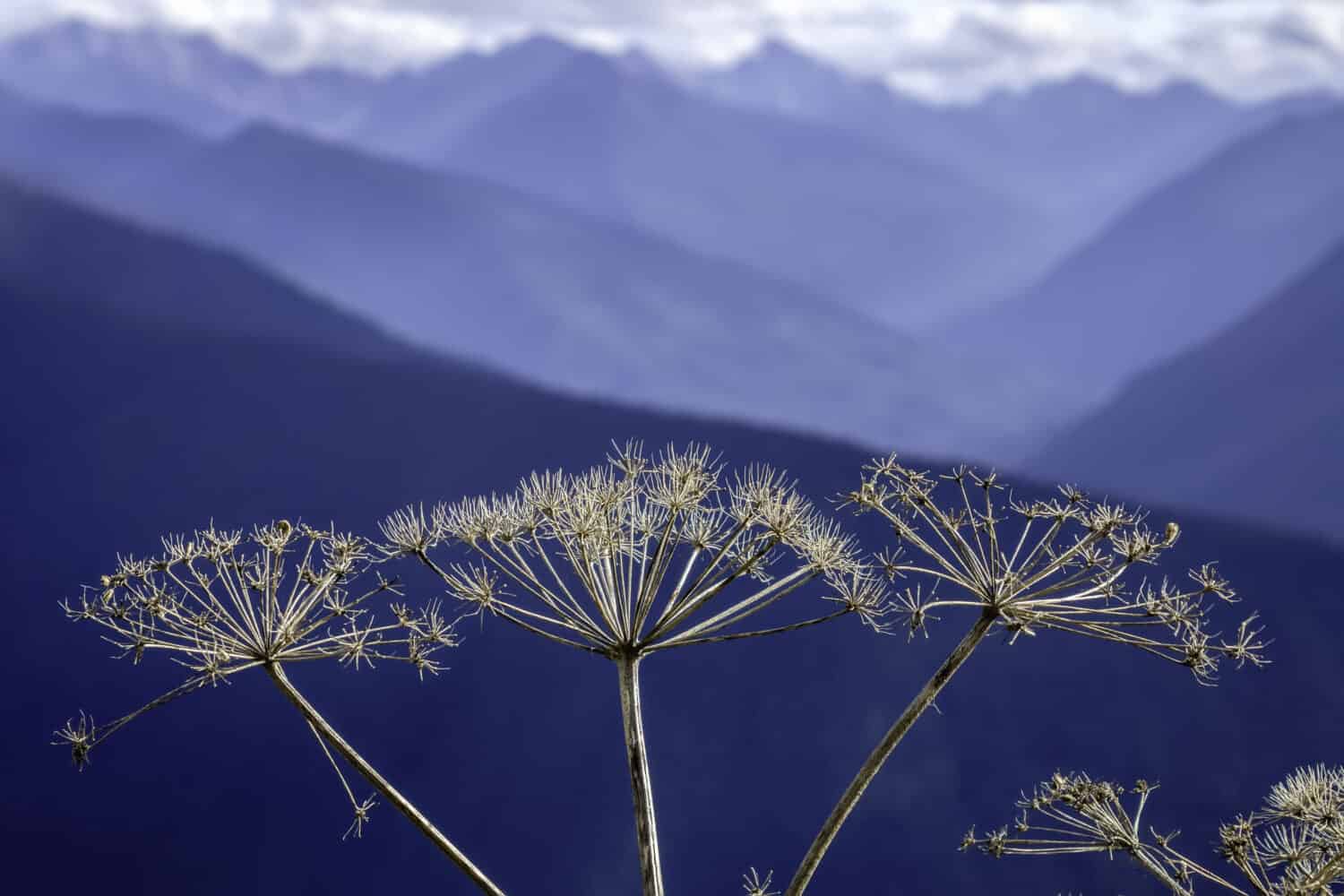
The toxic cow parsnip plant is sometimes mistaken for giant hogweed, but they are not the same plant.
©ESB Essentials/Shutterstock.com
The poisonous cow parsnip plant is an herbaceous perennial with big, lobed leaves and large umbrella-shaped clusters (umbels) of white flowers. This tall plant grows up to 10 feet high and looks similar to giant hogweed. Cow parsnip is also a member of the carrot family and has a long bloom season from late winter through late summer.
You can find this poisonous Indiana plant in woodlands, meadows, and near stream banks. But don’t confuse cow parsnip for a wild carrot plant because touching cow parsnip with your bare hands could cause a burning skin rash.
Plant Toxicity: Cow Parsnip
Cow parsnip produces toxic chemicals called furanocoumarins that cause strong allergic reactions on the skin. The resulting symptoms of phytophotodermatitis caused by these toxins are especially severe when the skin is in direct sunlight. Symptoms of cow parsnip poisoning can include an itchy and burning rash, painful blisters, and possibly permanent scarring.
4. Poison Ivy (Toxicodendron radicans)
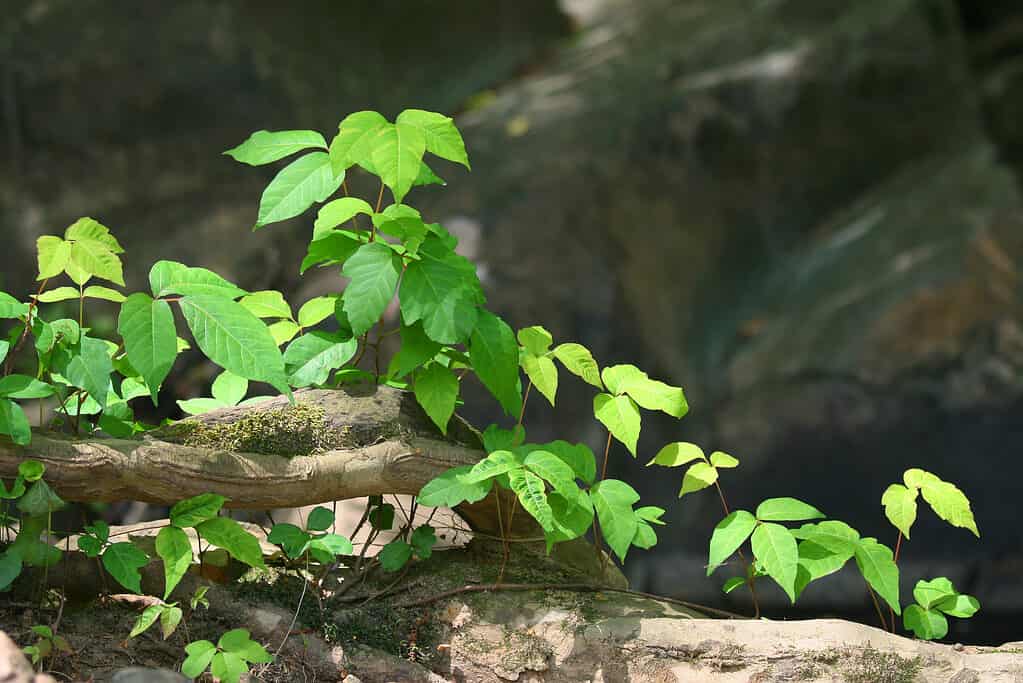
Poison ivy is a toxic plant that causes allergic reactions on the skin when touched.
©iStock.com/email2ying
The poison ivy plant is relatively easy to recognize due to its iconic sets of 3-leaflets and vining growth habit. This poisonous plant found in Indiana is also a woody shrub with leaves that can vary in shape, texture, and glossiness. In summer, its leaves are green. And in autumn, the poison ivy leaves turn yellow and reddish-orange. In addition, this plant will creep upward and outward as much as 75 feet in shady wooded areas, fields, and along fences.
Plant Toxicity: Poison Ivy
Poison ivy plants are dangerous because they contain a toxin called urushiol that releases when the plants are disturbed. So touching or brushing your bare legs against this plant can cause an itchy skin rash, swelling, and blistering. Symptoms of poison ivy poisoning can last a few days or a couple of weeks in severe cases.
Urushiol is also the toxin in poison oak and poison sumac plants.
5. Poison Hemlock (Conium maculatum)

Ingesting any part of the poison hemlock plant could be life-threatening.
©iStock.com/gabrielabertolini
The poison hemlock is a tall, upright plant topped with small umbels of white flower clusters. It also grows fern-like green leaves on stalks that can reach up to 10 feet tall. Poison hemlock is a highly toxic plant that thrives in Indiana waste areas, irrigation ditches, along roadsides, and fields.
Be aware that poison hemlock plants resemble wild carrot plants, but you can quickly note one significant difference. Poison hemlock plants have spotted stems, but wild carrot plants do not.
Plant Toxicity: Poison Hemlock
Ingesting any part of the poison hemlock plant can be deadly because of its powerful neurotoxins, including coniine. Symptoms of poison hemlock poisoning could include weakness, nausea, vomiting, dizziness, convulsions, muscle paralysis, respiratory failure, coma, and death.
6. Jimsonweed (Datura stramonium)
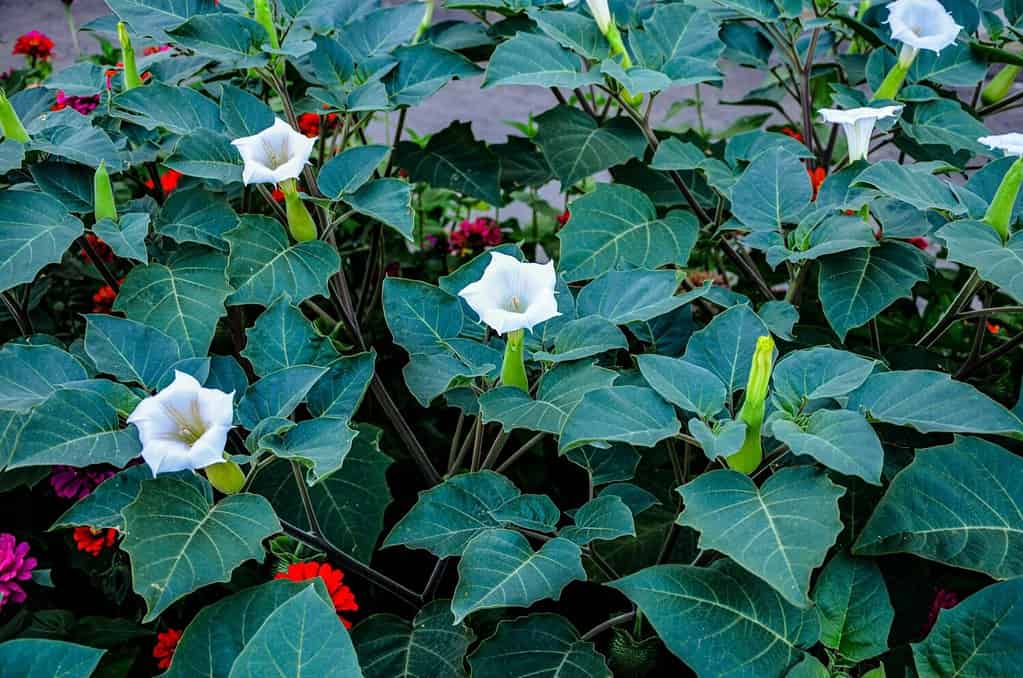
Poisonous jimsonweed plants have the nickname “stinkweed” because of their unpleasant smell.
©weha/Shutterstock.com
The jimsonweed has the nickname stinkweed because of its unpleasant smell, but its trumpet-shaped flowers are beautiful. Jimsonweed is a poisonous plant found in Indiana with psychoactive compounds that can cause hallucinations and life-threatening symptoms.
This 3-5 foot tall herbaceous plant has white and purple blooms, plus big and dark green lobed leaves. Jimsonweed thrives in the garden, as well as in disturbed and marginal areas like roadsides.
Plant Toxicity: Jimsonweed
Avoid ingesting any part of the jimsonweed plant because of its toxic alkaloids. Two of this plant’s main toxins are scopolamine and atropine. The symptoms of jimsonweed poisoning include dry mouth, rapid heartbeat, confusion, dilated pupils, blurred vision, hallucinations, coma, and possibly death.
7. White Baneberry (Actaea pachypoda)
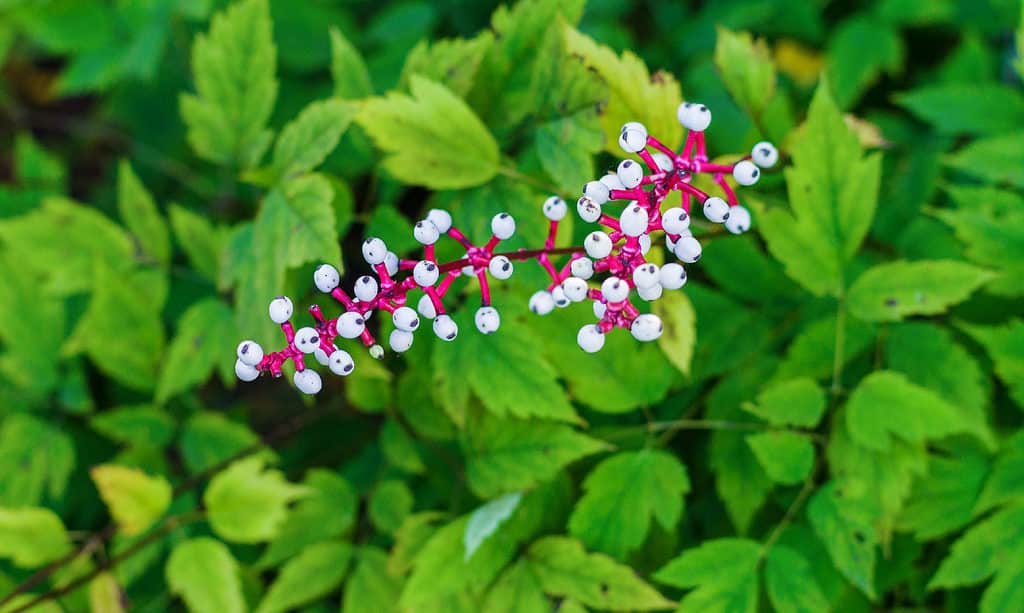
The white baneberry or “doll’s eye” plant is highly toxic, including its white berries with black dots.
©Alex Polo/Shutterstock.com
The white baneberry plant is easy to spot growing in Indiana when its white berries are in season. This fact is because each “doll’s eye” white berry has one black spot. Other features of white baneberry plants include toothed, oblong leaves and thick green stalks (called pedicels) that turn dark pink.
White baneberry habitats include forests, woodlands, thickets, and other shade-filled environments.
Plant Toxicity: White Baneberry
The white baneberry is one of the most poisonous plants found in Indiana because it has cardiogenic toxins that can harm the heart. This plant also contains ranunculin, which is an unstable glucoside that breaks down into glucose, and a toxin called protoanemonin. Baneberry’s toxins lead to skin rash and blistering if the plant is touched, plus worse symptoms if ingested. Eating its poisonous berries or other parts of white baneberry plants can result in nausea, vomiting, stomach cramps, dizziness, rapid pulse, delirium, and circulatory failure that could be fatal.
8. Stinging Nettle (Urtica dioica)

The stinging nettle contains toxins in the stinging hairs under this plant’s leaves.
©iStock.com/Dmitri Zelenevski
Prickly stinging nettle plants feature loads of stinging hairs under the leaves, so don’t touch them with bare hands! Stinging nettle has toothed and heart-shaped leaves. It also produces small clusters of greenish-yellow flowers.
The stinging nettle grows in areas with wet soil, like banks of rivers and streams, woodlands, meadows, and Indiana forest edges.
Plant Toxicity: Stinging Nettle
In addition to the sharp hairs on its foliage, stinging nettle contains neurotoxins like the neurotransmitters histamine, formic acid, and acetylcholine. So when you touch stinging nettle plants, the sting is partly due to these chemicals. Symptoms of stinging nettle poisoning include burning sensations on the skin that last up to 24 hours. However, some allergic reactions to the neurotransmitters could be more severe.
9. Water Hemlock (Cicuta maculata)
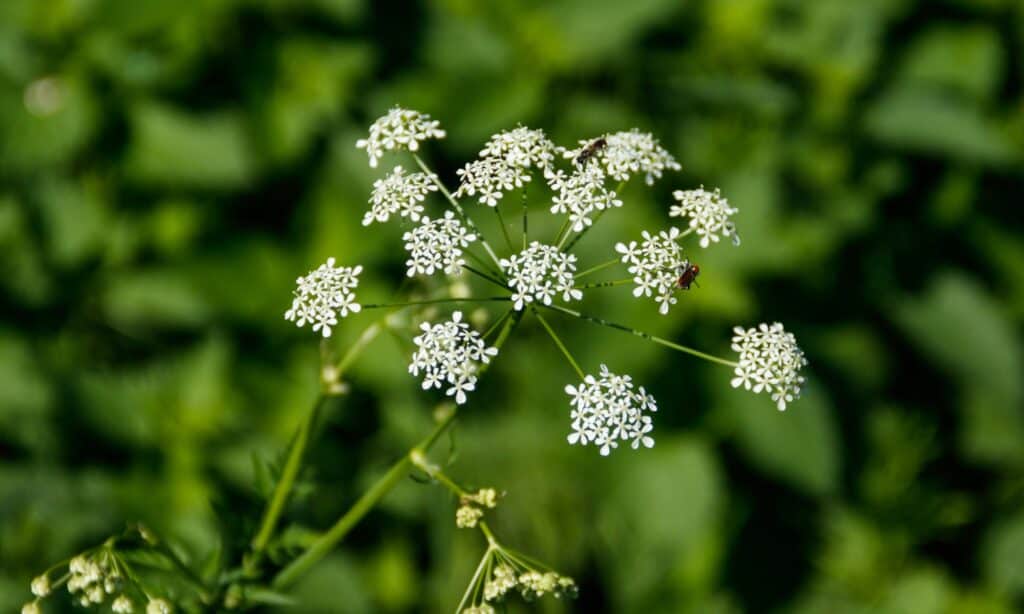
One of the most dangerous plants in Indiana is the water hemlock, which is a relative of the poison hemlock plant.
©iStock.com/OlyaSolodenko
The water hemlock is a highly poisonous plant that grows in Indiana. It’s a tall, perennial plant with lanced leaves and umbrella-like clusters of small white flowers. Its stems are spotted, long, and hollow. And the whole plant can reach 6 feet high. Like poison hemlock, water hemlock resembles wild carrot plants and Queen Anne’s lace.
Water hemlock habitats include areas in and near water, like swamps, streams, and marshes.
Plant Toxicity: Water Hemlock
The unsaturated alcohol called cirutoxin is the primary poison in water hemlock, and it’s a potent one. Ingesting any part of this plant is extremely dangerous, causing tremors, seizures, respiratory failure, nervous system failure, and death.
10. Wild Parsnip (Pastinaca sativa)

Touching wild parsnip plants could cause a burning rash that results in scarring of the skin.
©R. A. Nonenmacher / CC BY-SA 4.0 – License
The wild parsnip is a poisonous plant with small yellow flower clusters arranged in umbrella shapes. It also produces deeply divided, compound leaves on 2-5 feet-tall plants. And it’s a common wildflower in Indiana fields and disturbed areas.
Plant Toxicity: Wild Parsnip
Wild parsnip is a dangerous Indiana plant because touching it can cause phytophotodermatitis caused by chemicals called furanocoumarins. The symptoms of phytophotodermatitis include an itchy and burning rash, blisters, and possibly scarring. These symptoms are even more severe when the affected skin is exposed to direct sunlight.
11. Pokeweed (Phytolacca americana)
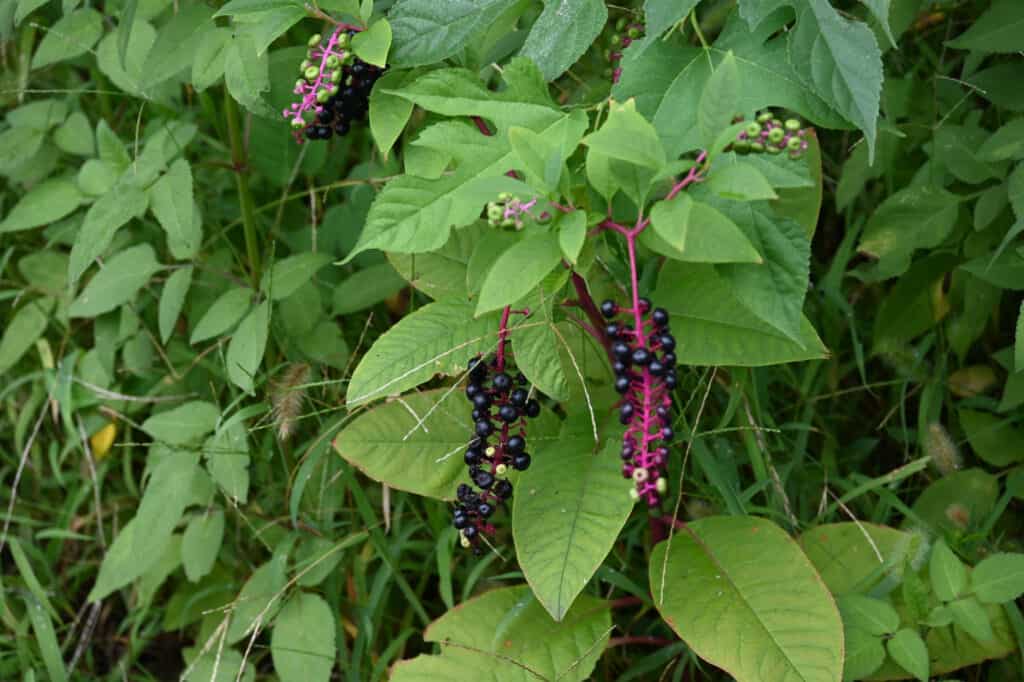
The highly poisonous pokeweed plant has dark pink stems and dark purple berries.
©tamu1500/Shutterstock.com
With its wide leaves, dark pink stems, and dark purple berries, it’s no wonder that people are attracted to the pokeweed plant. However, this large poisonous plant found in Indiana is highly toxic. Pokeweed grows 6-10 feet tall and thrives in disturbed areas, fields, and edge habitats like fence rows and roadsides.
Plant Toxicity: Pokeweed
Pokeweed toxins like phytolacca and saponins make all parts of this plant poisonous if ingested. The symptoms you could suffer from pokeweed poisoning include nausea, vomiting, diarrhea, convulsions, stomach cramps, and respiratory failure, which could be fatal.
The poisonous plants found in Indiana require safety precautions.
There’s no question that Indiana is a beautiful state with extraordinary plants. But it’s also true that some of them are very dangerous! Whether growing in forests, fields, or wetlands, these 11 poisonous plants found in Indiana require safety precautions for humans and the animals in their care. Protect yourself from plant poisoning by learning about them, wearing protective clothing, and steering clear of unfamiliar species. And don’t wait for symptoms to appear if you’re exposed to toxic plants. Get support from poison control or emergency medical care immediately.
Summary of 11 Poisonous Plants Found in Indiana
| Poisonous Plant | Toxicity | |
|---|---|---|
| 1 | Autumn Crocus (Colchicum autumnale) | Contains a toxic alkaloid called colchicine which causes nausea, diarrhea, vomiting, stomach pain, or life-threatening organ failure and cardiac collapse |
| 2 | Belladonna (Atropa belladonna) | Toxic tropane alkaloids can cause dry mouth, vomiting, rapid heartbeat, dilated pupils, blurred vision, difficulty swallowing, delirium, hallucinations, respiratory failure, and death |
| 3 | Cow Parsnip (Heracleum maximum) | Toxic chemicals called furanocoumarins can cause strong allergic reactions on the skin like itchy and burning rash, painful blisters, and possibly permanent scarring |
| 4 | Poison Ivy (Toxicodendron radicans) | Toxin called urushiol causes itchy skin rash, swelling, and blistering |
| 5 | Poison Hemlock (Conium maculatum) | Powerful neurotoxins including coniine can cause weakness, nausea, vomiting, dizziness, convulsions, muscle paralysis, respiratory failure, coma, and death |
| 6 | Jimsonweed (Datura stramonium) | Toxins scopolamine and atropine can cause dry mouth, rapid heartbeat, confusion, dilated pupils, blurred vision, hallucinations, coma, and possibly death |
| 7 | White Baneberry (Actaea pachypoda) | Contains cardiogenic toxins that causes nausea, vomiting, stomach cramps, dizziness, rapid pulse, delirium, and circulatory failure that could be fatal |
| 8 | Stinging Nettle (Urtica dioica) | Contains neurotransmitters histamine, formic acid, and acetylcholine that causes burning sensations on the skin that last up to 24 hours, and possible allergic reactions |
| 9 | Water Hemlock (Cicuta maculata) | Contains potent cirutoxin which causes tremors, seizures, respiratory failure, nervous system failure, and death |
| 10 | Wild Parsnip (Pastinaca sativa) | Chemicals called furanocoumarins can cause phytophotodermatitis, symptoms including an itchy and burning rash, blisters, and possible scarring |
| 11 | Pokeweed (Phytolacca americana) | Contains toxins like phytolacca and saponins that cause nausea, vomiting, diarrhea, convulsions, stomach cramps, and respiratory failure, which could be fatal |
The photo featured at the top of this post is © iStock.com/gabrielabertolini
Thank you for reading! Have some feedback for us? Contact the AZ Animals editorial team.







